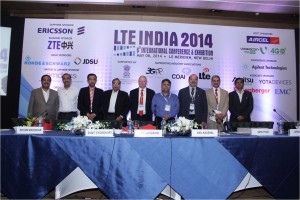New Delhi, May 8, 2014: After Government allowed network sharing, spectrum sharing and affordable devices would drive use of data dominant telecom systems like 4G and Long Term Evolution (LTE) soon.
“Spectrum for introducing LTE is now available. Almost 6.9 billion mobile subscribers are now been covered by mobile phone networks,” said Mr. Anil Kaushal, Member- Technology, Ministry of Communications & IT, Govt. of India during the inaugural session at 6th LTE India 2014.

Mr. Shashi Dharan, MD, Bharat Exhibitions,2. Mr. Shyam P Mardikar, Chief – Strategy, Architecture & Engineering, Bharti Airtel Limited, 3.Mr. Sumit D. Chowdhury, President- Enterprise, Reliance Jio Infocomm Ltd., 4. Shri Vipin Tyagi, Director & Member of Board, Centre for Development of Telematics (C-DOT), 5.Mr. Adrian Scrase, Head of Mobile Competence Centre, 3GPP & CTO, ETSI 6. Shri Anil Kaushal, Member – Technology, DoT, Ministry of Communications & IT 7. Mr. Arvind Bali, CEO – Mobile Services, Videocon Telecommunications 8. Mr. Vikram Tiwathia, Associate Director General, Cellular Operators Association of India (COAI) 9.Mr. Dinesh Chand Sharma, Director – Standardization, Policy and Regulation, Seconded European
Standardization Expert in India (SESEI)
According to Mr. Adrian Scarse, Head of Mobile Competence Centre, 3GPP & CTO, ETSI, telecom technology has moved beyond fourth generation and fifth generation networks would be a reality by next year. Significant research and development work is already going on in 5G.
Smart phone usage is catching up very fast particularly amongst the young Indian population. Mr. Shyam P. Mardikar, Chief-Strategy, Architecture & Engineering, Bharti Airtel Ltd. quoted, “Data claims that India has the second largest smart phone subscriber rate across the world. The growth rate was 60 per cent in Taiwan and 52 per cent in India by 2013, though the subscriber base was only 67 million which amounted to just 6 per cent of the total mobile phone subscriber base of over 950 million.”
Currently, there are 279 commercial networks in 101 countries where 536 operators are investing across 157 counties. Smartphone users in urban India crossed 51 million in 2013, a 89% growth and expected to cross 104 million by the end of 2014.
“Flatter architecture is becoming first mile transforming networks. Dynamic and on demand capacity would force networks to move closer and closer to users”, Mr. Mardikar said outlining the future in telecom service. With the usage of smart phones by the travelers for data transfers, National Highway 8 is facing very high data traffic. Describing a landscape of closely linked wireless devices across the country from Cars to e-readers to healthcare and in every other sector, there would be 50 billion wireless connected devices by 2025 world-wide”, said Mr. Sumit D. Chowdhury, President- Enterprise, Reliance Jio Infocomm Ltd. His new book “Rules of the Game” dealing with the challenges of the emerging connected world was released at the meeting with the first copy being given to Telecom Commission Member Technology Anil Kaushal. Connected spaces and places, emerging connected verticals, smart agriculture, connected car, e-Health and others will create network as an intelligent platform, he pointed out.
“The challenge for telecom service provider in the coming years would be to provide one Rupee per Gigabit over 100 Mbps by 2020 to everyone”, said Mr. Vipin Tyagi, Director & Member of Board, Centre for Development of Telematics (C-DOT). Users would expect digital action in real time in their daily work and play. Indigenous research development like GPON technology by C-DOT has reduced costs.
“LTE deployment is slowly picking up in the Indian market and we are now neck-to-neck with the global market. While India was almost 10 years late with 2G and almost Six (6) years late with 3G as compared to the global market,” said Mr. Ranjan Sharma, Director Technical & Commercial, ZTE Telecom India.
Expert speakers also included Mr. Arvind Bali, CEO-Mobile services, Videocon Telecommunications, Mr. Vikram Tiwathia, Associate Director General, COAI and Mr. Dinesh Chand Sharma, Director- Standardization, Policy & Regulation, Seconded European Standardization Expert in India.
Making it truly global platform to conduct business, global majors engaged in wireless broadband technology – Aircel, Videocon Telecom, Ericsson, ZTE, Amdocs, JDSU, Rohde & Schwarz, Agilent Technologies, Anritsu, EMC, Rosenberger, Yota Devices had participated at the event. Around 500 business delegates had participated representing senior people from telecom operators, equipment providers, regulators, Telecom Ministry, Infrastructure providers, Content Companies, System integrators, Trade Associations etc.






